

(a) Tips for OK-432 intracystic injection
therapy
The most important point of this therapy is to inject OK-432 surely
into the cyst. This therapy is the therapy to cause inflammation
in the cyst by OK-432 (penicillin killed streptococcal preparation).
If OK-432 was injected extracystically, it is not effective and
may cause only inflammation of injected site.
When I treat plunging ranula, I usually make local anesthesia
at the top of swelling with 1% lidocaine using small needle. Of
course, I must care for the injury to submandibular branch of
facial nerve. Then puncture the site with big (18 gauge) needle.
The cyst fluid in ranula is very viscous, so big needle is needed.
In some cases, ask the patients to try themselves to be prominent
their submandibular swelling as much as possible.
Ogita's original method was replacement of the cyst fluid with
OK-432 solution (0.05 KE/ml). I have treated plunging ranulas
by this method. The weak point of this method is that OK-432 is
sometimes injected extracystically. So, now I don't aspirate all
fluid. I aspirate almost half fluid then inject OK-432 solved
with 2 ml of saline. The dose of OK-432 is basically 1 KE. If
it was not effective, the dose of OK-432 was gradually increased
to 2 KE.
As for the position for treatment, I am treating with the sitting
position. The reason is that the puncture is sometimes difficult
because the cyst withdraws in the supine position.
What should we do when blood
vessel was punctured?
As you know, the density of blood vessels is high around submandibular
gland. It is not rare to puncture vessels in the procedure of
this treatment.

These are X-ray CT and cyst fluid of plunging ranula 3 in this
HP. This was very small cyst. At first, typical yellowish mucous
fluid was aspirated. Then, I tried to aspirate further and moved
needle. After that, blood was aspiratred. In this case, I returned
the needle and injected 0.5 KE. As a result, her ranula was cured
without trouble. If you puncture arteries and bleeding contined,
you should stop treatment. But, without such special case, I think
you can complete this therapy even if bleeding was observed. Administration
route of OK-432 approved now are (1) intramusucular and subcutaneous,
(2) intracavital, (3) intratumoral or around tumor. But, formally,
intravenous administration was also approved. And, I know the
paper that OK-432 was administrated into feeding artery of the
tumor.
(b) Tips for "Highly concentrated
OK-432 Injection Without Aspiration method".
I am using this method for oral ranula, lingual cyst, mucocele
of lip, otohematoma, median cervical cyst in children. If I treat
oral ranula with Ogita's original method, rapture after OK-432
treatment sometimes occurs. The cyst fluid of ranula is very viscous,
so big needle is needed to aspirate. If we puncture oral ranula
with big needle, leakage of OK-432 sometimes occurs from puncture
hole. And if OK-432 was successfully injected, rapture sometimes
occurs within a few days after treatment because big needle makes
weak point in the mucous membrane. In Roh's paper (reference 7),
the efficacy of treatment of oral ranula was low compared to that
of plunging ranula. He wrote that the reason was rapture.
So, now I am treating all oral ranula with "Highly concentrated
OK-432 injection without aspiration method". I usually inject
0.5 KE to small ranula which diameter is within 2 cm and 1 KE
to big ranula which diameter is more than 2 cm. OK-432 was suspended
very small amount,usually 0.2 ml, of saline using very small needle,
27 gauge,. OK-432 suspension is only injected into ranula. As
OK-432 is lyophilized streptococcus preparation, it can be solved
very small amount of saline. Because the total amount is OK-432
suspension is very small, the technical loss of preparation becomes
very big. To prevent loss by attachment of OK-432 solution to
vial cap, I am preparing OK-432 solution after vial cap was removed.
The merit of this method other than prevention of rapture is no
need of local anesthesia because the needle used was very small.
So, if they can open mouth for while, we can treat children as
out patients.
At first I was worrying about OK-432 would not dilute because
the cyst fluid was very viscous. But, it was free from care. The
effect was almost the same as Ogita's original method.
(c)About the dose of OK-432 and the
number of treatment times
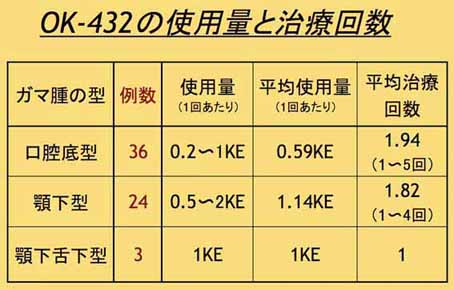
Please do not give up if the result of the first treatment
was insufficient. Please repeat at least 3 times. If you repeat
3 times, the efficacy for plunging ranula must be over 90 %.
This is the summary of dose and the number of treatment times
till June 2007.
In oral ranula, The dose of OK-432 used in each treatment were
from 0.2 KE to 1 KE. The average dose was 0.59 KE in each treatment.
The mean number of treatment times to cure was 1.94.
In plunging ranula. the dose used in each treatment was from 0.5
KE to 2 KE. The average dose was 1.14 KE in each treatment. The
mean number of treatment times to cure was 1.82.
Three combined ranula were all cured by only one time 1 KE of
OK-432 injection.
(d) About the forecast of the result
of OK-432 therapy
The
OK-432 intracystic injection therapy is the therapy that induce
strong inflammation in the cyst by OK-432 (killed streptococcus).
The final result will be recognized 6 weeks after treatment. But,
the estimation of the result can be possible by examination on
the next day after treatment. If there was inflammatory reaction
around the cyst, good result is fully expected. Concretely, change
of the color of ranula blue lucent to red cloudy in oral ranula
and increased swelling and reddened skin in plunging ranula predict
good result.
Left; Before
Treatment, Right: The next day After Treatment
(e) About
differential diagnosis of Plunging ranula
Diagnosis of plunging ranula
is not so easy. The following cases were diagnosed as ranula in
other hospitals. They were thought to be dermoid cyst. Especially
the lower case had much liquid content. So, a few ml of fluid
was aspirated. But, the amount of fluid was almost 5 ml and it
was serous fluid containing white debris.
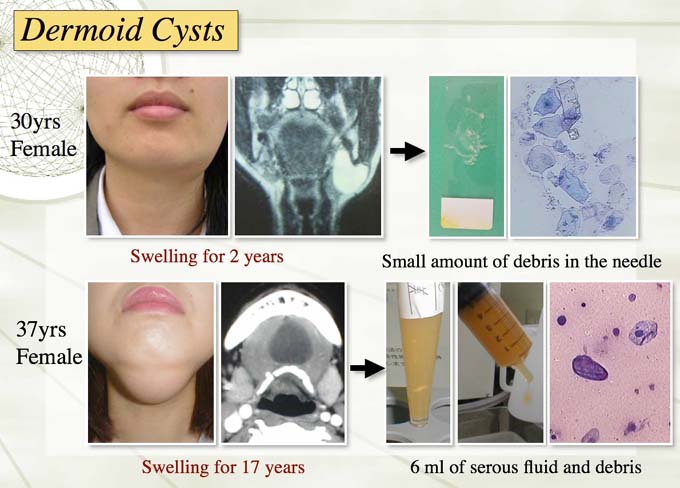
These are cases with dermoid cyst that I operated before.
Please suspect dermoid cyst first when ithe shape was round and
the size was not changed for a long time. In case of ranula, the
size usually changed periodically. And the shape of ranula is
sometimes complicated because the fluid was spread into neiboring
spaces.
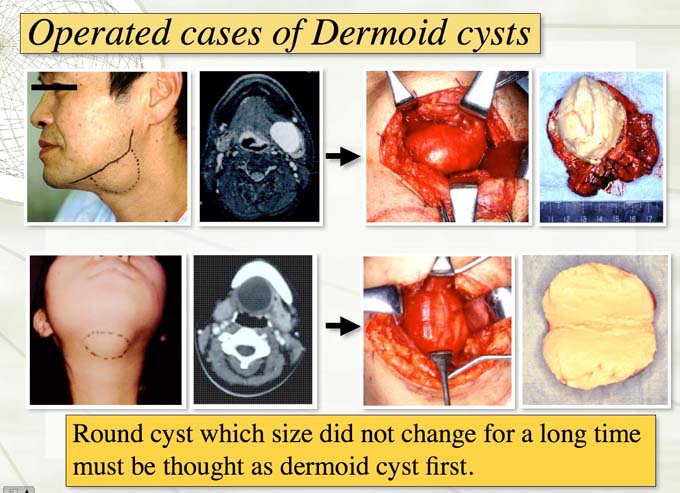
Other cases of dermoid cyst (Please click)
These are X-ray CT, MRI and intracystic fluid of 8 years old
boy with plunging ranula.
I usually tell to patients that "the diagnosis of plunging
ranula can be done after mucous collection in the cyst was confirmed
by aspiration".
The followings are MRIs of plunging ranula and dermoid cyst.
In many cases of plunging ranula, the shape of fluid collection
were irregular because the fluid enter into several neiboring
spaces.
In contrast, the shape of dermoid cyst were almost round.
Additionally, in the cases of ranula, the position and shape of
normal tissues such as airway, salivary gland remains normal.
If the position of air way was moved, or if the shape of submandibular
gland was deformed, please think dermoid cyst first.
But,
I experienced a ranula case who's submandibular
gland was deformed by compression of the cyst. So, there is
an exception.
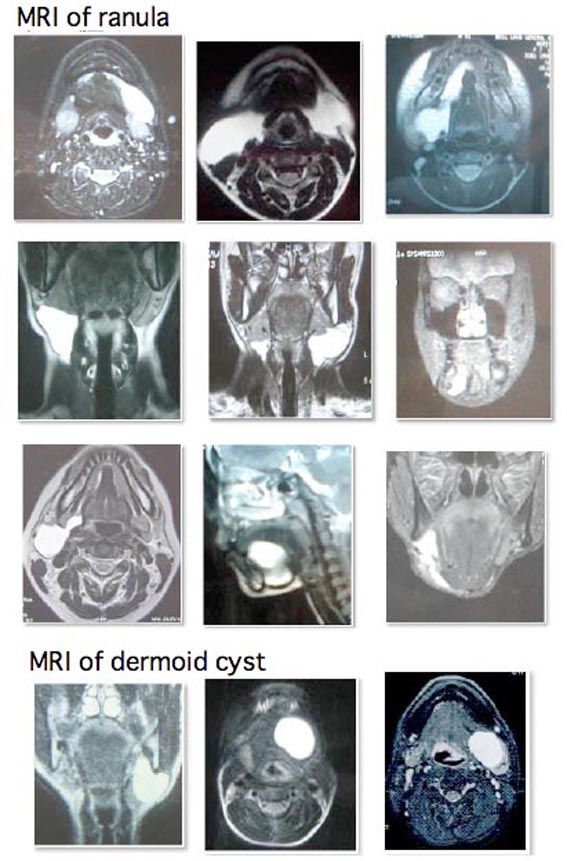
Upper 9 MRIs : Ranula, Lower 3 MRIs : Dermoid cyst
Other cases of dermoid cyst (Please click)
(f) About
side effects and how to deal with
The side effects of this
treatment are basically the same as streptococcal infection.
In general, fever up and local pain were observed.
The degree of these side effects was basically depended on the
dose of OK-432. Usually, they were controllable with oral analgesics
and diminished within 3 days.
As a special side effect in treating head & neck cysts, airway
stenosis rarely occurs. This side effect occurrs within a few
days after OK-432 injection. I know 2 cases of airway stenosis
of head & neck lympgangioma who needed tracheotomy.

In this case, airway stenosis was spontaneously
improved.
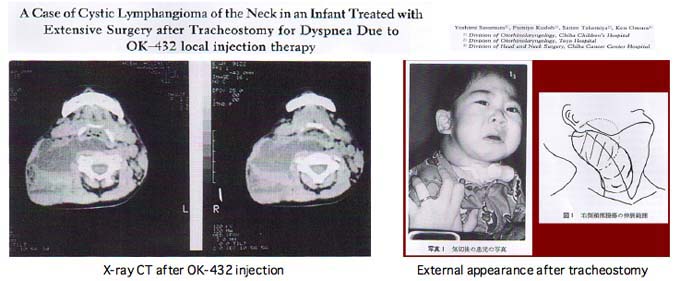
This is from reference 20 (Japanese).
One and 5 months old. 0.5KE of OK-432 was injected. Severe air
way stenosis was obseved. 10 days after OK-432injection, tracheostomy
was performed.
In contrast, I have never experienced
airway stenosis in the treatment of more than 100 cases with ranula.
I believe that ranula can be treated as an outpatient basis safely,
but lymphangioma near airway should be treated in hospital. Especially,
lymphangioma existed behind trachea (membranous portion) should
be paid attention extremely.
And, if OK-432 therapy was done after surgery, fistula formation
was sometimes observed. After OK-432 injection, temporary increased
swelling occurs. If there is weak lesion in skin or mucous membrane,
rapture sometimes occurs. In case with removal of submandibular
gland, rapture of the skin sometimes occurs because of no suspended
tissues under the skin. But, two cases I know were conservatory
healed only compression of wound for a few weeks.
Please Click here to go to English Page with frame (If you can't see frame, click it)